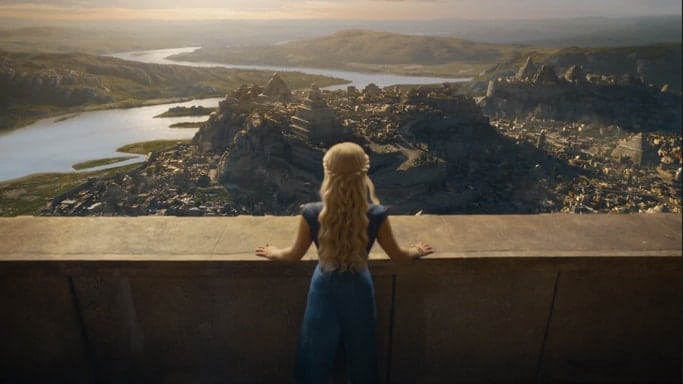World Building in Film & TV: The Essential Steps
If you’ve ever enjoyed losing yourself in the world of Harry Potter or Lord of the Rings, you know how important world building is.
After all, world building is what makes us suspend our disbelief and fully sink into a story. It’s also a large part of the reason we keep coming back for more even long after we know the plot by heart.
- Could you imagine Harry Potter without the exceptionally detailed wizarding rules and spells or Avatar without Pandora’s culture and lush landscapes?
- Would you still be so invested in Harry and company’s shenanigans or still be patiently waiting for Avatar’s decade-long overdue sequel?
- Even if your series is about a Californian biker gang, the world building aspect is key. Would SONS OF ANARCHY be as engrossing without all the quirky rules of its world?
These stories might still be good ones regardless, but their expansive, fleshed-out worlds are what elevate them above the average narrative.
So, world building is pretty important, but how are you supposed to actually do it? How do you create a deep, rich world from scratch? And how do you build it up without overwhelming your story?
To help answer these questions and guide you along your journey, we’ve compiled eight essential steps to successful world building.
Step 1- Decide on a World Type
It seems like an obvious step, but it’s also a crucial one. In order to craft a world that makes sense for your film or series, you need to decide whether it is a fantasy one, a “real one,” a sci-fi one, or another kind entirely.
This will inform a lot of the facets of your world such as climate, geography, languages, and politics.
Additionally, you’ll need to decide how much fiction or fact will go into your world, regardless of your world type. For example, you might pick a realistic world type, but you’ll still need to figure out how close it is to our world:
- Is it an exact replica or does it deviate?
- Or is it a completely different world that happens to share a lot of commonalities with our own?
- Is it similar culturally, geographically, politically to our world or not at all?
These are questions to ask of fantasy and sci-fi worlds as well.
Step 2- Find Inspiration in Other World Building
They say imitation is the sincerest form of flattery.
George RR Martin, for example, famously took great inspiration for Game of Thrones from Lord of the Rings and it’s clear to see. The twists on such a world, however, make it clear that it is a homage not a rip off.
As one would expect, world building is infinitely easier if you know what aspects you like and what you do not. For example:
- Are you a huge fan of Star Trek?
- Is it because of the complex interactions and relations between different cultures and species?
- Do you appreciate Klingon and how it is actually a language you could learn?
- Is it because of the varied worlds that look completely different to ours?
Narrowing down what you appreciate from movies and series like this will help you narrow down the elements you should include in your own world building.
Step 3- Free Write and Find the Details
Now that you have some inspiration, you need to find ways to include this in your writing and start developing some more personalized ideas.
You can and should do this at various stages in the writing process, but it can be extremely helpful to do it earlier on.
Sometimes it’s easier to build out from specific ideas to more general ones. So, if you have a great idea for a planet, species, or culture, write it down and go from there!
For example, maybe you’ve decided to create a planet that is almost entirely water. This might inform a type of species you want to create.
- Maybe you want to create a species of super advanced squid or focus on making a deadly algae.
- Or perhaps it will inspire you to use the water as a source of tension or conflict.
- Maybe instead your story will focus around a deadly upcoming ice age or political struggle over ocean resources.
It might seem a silly example, but it illustrates how world building is a puzzle. Sometimes just one detail can make several others fall into place.
Step 4- Shape its Appearance
With some important details now figured out, it’s time to more specifically focus on appearance. It’s time to answer the question: “What does my world look like?”
You may have figured out some of this in brainstorming your topic, but its time to refine it. Whether they be other planets or a world similar to ours, what does the landscape your story takes place within look like?
- Is it big or small, rocky or gaseous, is there a lot of water or land?
- What color is the sky?
- What does its fauna look like? Is it very lush or barren?
- What are the seasons like?
These are all important questions to consider. The answers will have big ramifications for your world building and will once again inform other parts of the world and story.
Additionally, it’s important to consider the appearance of your characters and the appearance of the things you won’t see. Both of these things impact how your characters interact and move through your world, and also makes the world feel more expansive.
You want to avoid feeling like your world was made for your characters or plot. Rather, you want them to feel like a natural part of a bigger, more realistic-feeling world.
Step 5- Create Your Cultures
Creating different cultures is another extremely important aspect of the world building process. Like with crafting your world’s appearance, you should focus on the small details of your world’s cultures even if they aren’t prominently featured.
You need to know how the cultures vary, how they’ve changed, and how they are viewed by other cultures, on top of the general need-to-knows like traditions, religions, languages, and social norms.
This will make your world feel significantly more natural and will reduce the distance between it and the viewer. It sets your world up as more organic, expansive, and believable — all characteristics of great world building.
Of course, you don’t want to focus so intently on this step that it swallows your characters or plot, or that it distracts you from the rest of your screenwriting. Make sure to use it as an important writing tool rather than a built-in procrastination excuse.
Step 6- Construct a Historical Timeline
This is often one of the most complicated and time consuming steps of the world building process, but its another crucial layer.
Constructing a thorough historical timeline gives depth and background to your film or series and gives important context to your world, character’s motivations, cultures, and more.
However, keeping historical events straight and cohesive is tricky. Be prepared for plenty of gaps, contradictions, and half-baked explanations.
Even the best screenwriter will have plenty of dots that desperately need connecting and writers will get called out all the time. Rather than worry about this to the point you just avoid it, focus on the big stuff first then fill in the gaps.
If you are struggling, examine how other writers’ timelines or take inspiration from real world history. Even in sci-fi and fantasy, the why behind important historical events and the impact of cause and effect largely still apply.
Game of Thrones is a great example of a story that has a complex and detailed historical timeline behind it. Furthermore, it borrows and takes inspiration from a great deal from real history, such as the Wars of the Roses.
It’s also a great example of how such a detailed history and lore can prove richly rewarding for audiences. It creates engagement outside the actual show itself, giving it longevity and return-ability.
Step 7- Determine World Building Influences
The last main step in world building is also a major step in crafting your plot — determining the major world influences.
- What force is exerting influence on your settings, characters?
- What is forcing the world to change?
- Is it controllable or uncontrollable?
- Is it a major weather event, a shift in political power, a character’s influence?
- How will it change the world you’ve built?
- Is it reversible or will it change the historical timeline of the whole world going forward?
This often leads directly into your main conflicts, and will thus inform and be informed by other aspects of your writing.
Keep in mind that these influences don’t always have to be super overt or external. Internal conflict can just as easily be the main force of change.
Famous examples might be the return of Voldemort to the world in Harry Potter or the death of King Robert Baratheon setting off the titular game of thrones. These are the changes in the world that threaten to shift or change it.
Step 8- Wash, Rinse, and Repeat
The last and final step is to edit, edit, edit!
As you look through your work, there will be plenty of blanks, conflicting information, and loose-ends that you will need to tie-up. Once you find these, you can repeat these steps to further flesh things out and provide a sense of continuity.
It’s also at this final step that you might find creating maps, planet profiles, physical timelines, and behind-the-scenes histories helpful. They might be able to bring more clarity to where gaps lie and inspire some new material to fill in these gaps.
After a few rounds of these steps and some general editing, you should be left with a far better, more complex world that will keep your viewers coming back for more.
– What did you think of this article? Share It, Like It, give it a rating, and let us know your thoughts in the comments box further down…
– Struggling with a script or book? Story analysis is what we do, all day, every day… check out our range of script coverage services for writers & filmmakers.
Get *ALL* our FREE Resources
Tackle the trickiest areas of screenwriting with our exclusive eBooks. Get all our FREE resources when you join 60,000 filmmakers on our mailing list!


